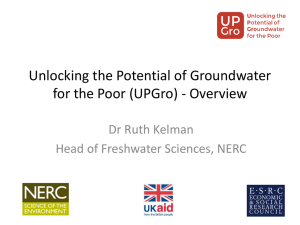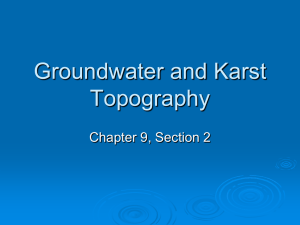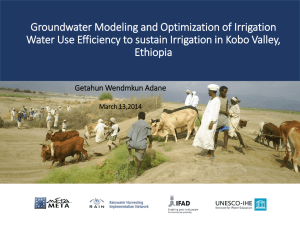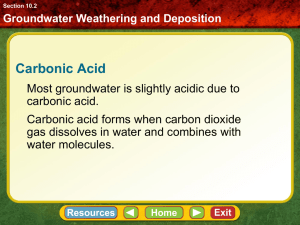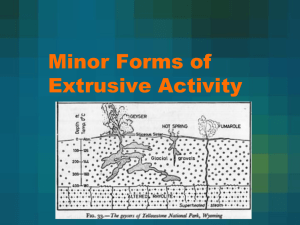See lecture slides - Bren School of Environmental Science
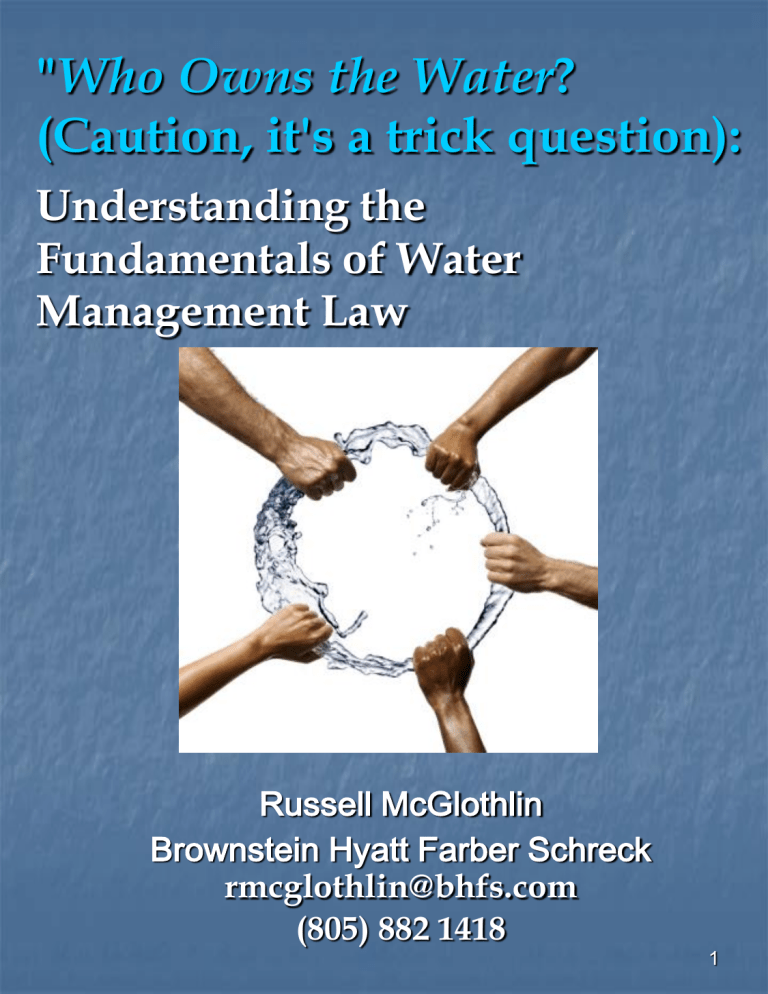
"Who Owns the Water?
(Caution, it's a trick question):
Understanding the
Fundamentals of Water
Management Law
Russell McGlothlin
Brownstein Hyatt Farber Schreck rmcglothlin@bhfs.com
(805) 882 1418
1
"Whiskey is for drinking; water is for fighting over."
2
Water Law & Policy
Who/What Gets the Water?
Under What Conditions?
Are Policy and Law in Synch?
3
The Qualifications
Confusing
States Use Different Approaches
Frequent Exceptions to the Rules
The Law is Sometimes Not Well-
Suited for the Science
Not Always Logical/Practical
Goal = Introduction. Basic
Understanding.
4
“
Things should be as simple as possible, but not simpler.
”
~
Albert Einstein
5
Water Policy Questions
6
Water Policy Questions
7
Water Policy Questions
8
What Defines Water Use
Law in the U.S.?
Mostly State Law (Federal Reserve
Rights = Exception)
Three Approaches: Riparianism, Prior
Appropriation, and Hybrids
Surface Water vs. “Groundwater”
Who Regulates/Manages?
Groundwater Law is Less Developed and is Still Evolving
Private Water Rights to Use Water –
Publicly Regulated
9
Tragedy of the
Commons
10
Water is a Unique
Resource Because it is
Shared and Transient
11
Are Water Rights
Property?
12
Public v. Private
CA Water Code section 102: All Water
Within the State is the Property of the
People of the State, but the Right to the
Use of Water May be Acquired by
Appropriation in the Manner Provided by
Law.
Initiation of Water Use Subject to Public
Interest Review and Ongoing Police Power
Regulatory Oversight; Inherent Aspect of the Right
Think Zoning
Key Point: Right to Use = Property Right
Subject to Regulatory Regime
Debate Over Where to Draw the Line?
Public Trust, Regulatory Takings, etc.
13
Beneficial and Reasonable
Use Limitation
With Few Exceptions, All States
Apply Some Form of Beneficial and Reasonable Use Limitation on the Right to Use Water
14
What is Unreasonable/
Non-Beneficial?
Speculation? Water Rights in “ Cold
Storage?
”
Reasonable Efficiency or Optimal Use?
(Alfalfa, Golf Courses, Artificial Lakes in the Desert?)
Harm to Environmental and Other
Public Trust Considerations?
Is Good Public Policy Served by
Allowing Courts to Determine Optimal
Use? Legislature?
Alternative: Markets??? Challenges???
15
CA Examples of Unreasonable
Methods of Use and Non-
Beneficial Purposes of Use
Use of Full Flow of Stream to Maintain
Accretion (Sediment Buildup) to
Downstream Riparian Land --
Chow v. Santa Barbara (1933);
Gin
Flooding of Fields to Kill Gophers --
Tulare Irr. Dist. v. Lindsay-Strathmore
Irr. Dist.
(1935)
16
Three Approaches to Water Law: the Old, the New, and the Ugly
Riparianism (The Old): Land with Water
= Riparian Water Rights
Prior Appropriation (The New): Land is
Irrelevant – First-in-Time is First-in-Right
Hybrid (The Ugly): Riparianism and Prior
Appropriation
17
Riparianism
Origins in English Common Law
Riparian Right - the Right to Divert Water from a Water Body Adjoining Land for Use on Adjoining Land
The Right is an Incident of the Rights to the
Land (i.e., Part of the “ Bundle ” of Rights)
Essentially Two Doctrines:
Natural Flow - Right to the Entire Flow of
the Stream - Minor Exceptions
Reasonable Use - Right to Divert for
“ Reasonable ” Uses. Related Doctrines:
Correlative Rights Doctrine and 2 nd
Restatement of Torts
18
Natural Flow Doctrine
(Old English Rule)
Riparian Owner Possessed the
Right to the “Full” Flow of the
Stream “Undiminished as to
Quality or Quantity”
“Domestic” Uses Allowed
Pre-Industrial England
19
Reasonable Use Doctrine
(New American Rule)
Natural Flow Doctrine Not Well
Suited for the Industrial Age
Courts and Legislatures Amend Old
English Common Law to Allow for
Irrigation and Industrial Uses So
Long as Water is Used Reasonably
Correlative Rights Doctrine
Adopted in Some States –
Riparians Share Supply
20
Riparian Rights
Appurtenant to Land; Right to Use Water from Adjoining Water Body
Traditionally Must be on Riparian Land
(Exceptions Apply)
Reasonable Use
Rights May be Correlative (i.e., Riparians
Share the Supply)
Right May be Inchoate (i.e., Dormant) - Not
Dependent on Historical Use
21
Criticism of Riparian Rights -
The Need for Certainty
Unrecorded, Unknown Quantity –
Can Preempt Vested, Long-
Standing Uses
Uncertainty Deters Long-Term
Planning and Investments in Water
Rights and Infrastructure
Dormant Rights Impair
Administration of Water Rights
Because of Uncertainty
Not Well Suited for Water-Scarce
Environments
22
Prior Appropriation
Developed in Western Mining Camps
Because Riparianism Was Not Well-
Suited for Miners (Miners Were Largely
Trespassers on Public Lands)
Water Disputes Rapidly Escalate
Perfection of Right Through Posting
Notice at Place of Diversion and
Commencing Diversion
23
Appropriative Rights
May Apply to Use Off of Riparian Tract
Defined by Historical Quantity of Use
Priority Based Upon First-In-Time, Firstin-Right
May be Forfeited (i.e., Lost) by Non-Use
May Require State Permit
California: State Water Resources Control
Board
Colorado: Division of Water Resources (State
Engineer)
New Mexico: Office of State Engineer
Nevada: Division of Water Resources (State
Engineer)
24
Riparianism vs.
Prior Appropriation
Riparianism – Mostly in Eastern States and
Those Along the Mississippi (the Old)
Prior Appropriation – Mountain and
Western States (the New)
Hybrid States – Dual System States.
Generally, Recognize Riparian Rights that
Vested Before the State Changed to an
Appropriative System. (e.g., Kansas,
Nebraska, North and South Dakota,
Oregon, Texas, Washington)
California – the True Dual System State
25
California Water Law
Riparian Rights are First Priority Rights
Appropriative Rights are Second Priority
Rights
Surface Water Regulated by the State
Percolating Groundwater Regulated by
Local/Judicial Management if Regulated
26
Riparianism v. Prior
Appropriation
Conflict Between Miners
(Appropriators) and Landowners
Who Possessed Land Under
Mexican Land Grants (Riparians)
California Supreme Court Addresses the Conflict in Lux v. Haggin (1886)
27
And the Winner Is . . .
We Choose Both!!
Court Reasons that California ’ s
Adoption of the English Common Law
Included Adoption of the Riparian
Doctrine
However, Court also Acknowledges
Prior Appropriation but Renders
Appropriative Rights “ Junior ” in
Priority to Riparian Rights
28
Uncertainty fostered in California by riparian/overlying rights
California’s water law is a source of uncertainty because it endorses riparian/overlying rights and appropriative rights, with riparian/overlying rights being senior in priority
Dormant riparian rights are a principal source of uncertainty in
California – In re Long Valley
29
QUESTIONS???
30
What About Groundwater?
Often Separate Law Applies
Historically Viewed as an
Occult
Groundwater Law Not as Well
Developed in Some States
31
What is “ Groundwater ” ?
What ’ s the Issue? The Demarcating
Line Between “ Independent ”
Groundwater and Groundwater That is
Surface Water “ Dependent ” (Feeds or is Fed by Surface Watercourse)
Other Terms - Percolating
Groundwater vs. Subterranean
Stream; Surface Water Underflow;
Groundwater Flowing within Relatively
Impermeable Beds and Banks (Known and Defined Channel)
What is at Stake? Who Regulates?
Can I Get a Permit? Can I Be Sued or
Sue? Other Legal Implications
32
Difficult Issue Because it Pits
Countervailing Interests
Against One Another
Want Certainty to Support
Decisions to Plan and
Invest in Water Resources
Want “ Rational ” System that Appreciates the
Hydrologic Connection
Between Surface Water and
Groundwater
33
Potential Approaches
Rigid Separation – If It’s Under the
Surface, It’s Groundwater (e.g.,
Oklahoma)
Fully Integrated System – It’s All One
(e.g., Nebraska Gives Local Districts
Authority to Designate Integrated
GW/SW Management Areas)
Bright Line – Location of Groundwater
(e.g., (1) Within 1,000 ft of Stream and
Less than 200 ft Deep; or (2) Colorado -
Will Withdrawal Deplete SW Waterbody
Within 100 Years by More Than 1/10 of
1% of the Amount Withdrawn?)
Character of Groundwater – Focus on
Geology/Hydrogeology (e.g.,
Groundwater Flowing with Relatively
Impermeable Beds and Banks)
34
California
Percolating Groundwater v. Subterranean Stream
Percolating Groundwater: Vagrant,
Wandering Drops Moving By Gravity in
Any and Every Direction Along the Path of Least Resistance – City of Los Angeles v. Hunter (1909)
Subterranean Stream ( “ Groundwater
Flowing in Known and Definite Channel ” )
• Subsurface Channel Present;
• Channel Possess Relatively Impermeable Beds and Banks
• Course of Channel Capable of Being Known with Reasonable Inference; and
• Groundwater is Flowing in the Channel
Beds and Banks Test -
Pomeroy (1899)
Los Angeles v.
35
36
Groundwater Law:
The Approaches
Absolute Ownership/Rule of
Capture
Common Law Reasonable Use
Correlative Rights
2 nd Restatement of Torts § 858
Prior Appropriation
37
Rule of Capture
(
Absolute Dominion)
Rule of Capture = Get It and It’s Yours
The Water Hog Doctrine
8 States Have Adopted or Indicated a
Preference for Rule. Texas has the
“Most Pure” Capture Rule, But Now
Manages by Groundwater Districts
38
Reasonable Use and
Correlative Rights
Common Law Reasonable Use - Capture
Rule But Water Must be (a) Used on
Overlying Land, and (b) Put to
Reasonable Use
Correlative Rights – Based Upon
Reasonable Use Doctrine - Sharing of
Supply Among Overlying Landowners.
Share of Supply May be Based on Acres
Owned, Water Needs, etc.
At Least 34 States Use Some Form of
Reasonable Use Doctrine – Common Law
Reasonable Use (25 States), Correlative
Rights (6 States), 2 nd Restatement of
Torts § 858 (3 States)
39
Second Restatement of
Torts § 858
Landowner Can Produce Groundwater
Without Liability Unless the Withdrawal : a) Harms Neighboring Landowner’s
Groundwater Production; b) Exceeds Reasonable Share of Supply; or c) Has a Direct and Substantial Effect on
Watercourse or Lake, Which
Unreasonably Harms Person Entitled to
Use of Watercourse or Lake
Reasonableness Determined in Reference to Variety of Considerations
3 States Have Formally Adopted (Michigan,
Ohio, and Wisconsin)
Might be Used to Define Reasonableness in
Other States
40
Appropriative Rights to
Groundwater
Like Appropriative Rights to
Surface Water
Defined by Historical Quantity of Use
Priority Based Upon First-In-
Time, First-in-Right
41
California
Overlying Groundwater Rights:
Similar to Riparian Rights
Overlying Rights to a
Groundwater Aquifer Are
Analogous to Riparian Rights to a Surface Water Body
Same Legal Characteristics
Apply to Both Forms of Right
42
Riparian/Overlying
Rights
Appurtenant to Land; Right to Use Water from Adjoining Surface Water
Body/Underlying Aquifer
Use Must be on Riparian/Overlying Land
First Class Right (Senior to Appropriative
Rights)
Rights are Correlative (i.e., Equal Legal
Footing) with Other Riparians/Overlying
Owners; Conflicts Between
Riparians/Overlying Land Owners Settled
Pursuant to Reasonable Use Considerations
Right May be Inchoate (i.e., Dormant), and
Thus is Not Dependent on Historical Use;
Only Limited in Quantity by Reasonable and
Beneficial Use Criteria
43
California
The Water Rights Table
Source Subterranean
Stream
Percolating
Groundwater
Type of Right
Riparian
Or
Overlying
Owner
Appropriator
44
Overdraft . . .
The Rules Change . . .
Maybe
Adverse Basin Effects
Prescriptive Rights
Ramp-Down
Doctrine of Intervening Public Use
45
46
What is Overdraft?
Groundwater extractions in excess of safe yield
Safe yield defined as “ the maximum quantity of water which can be withdrawn annually from a groundwater supply under a given set of conditions without causing an undesirable result.
” City of Los Angeles v.
City of San Fernando (1975)
“ Undesirable results ” = water quality degradation, seawater intrusion, land subsidence, or uneconomic use of groundwater
Continual drop in water levels over time, even after wet years, leading to undesirable results City of Pasadena v. City of
Alhambra (1949)
47
What is the Effect of Overdraft on Groundwater Rights?
Overlying Owners Entitled to Enjoin
Appropriators (Junior Appropriators
Reduced/Eliminated First)
Adversity Commenced for Purposes of
Prescriptive Rights
Prescriptive Rights May be Obtained
After Satisfaction of the Four Elements of Prescription (Actual, Open and
Notorious, Adverse, Exclusive and
Continuous for Five Years)
Nuances Apply
48
49
Legal Rights to Store
Water Underground
In California “ Developer ” of Stored
Groundwater Has Exclusive Right to
Recapture the Stored Groundwater –
Los Angeles v. Glendale (1943) and Los
Angeles v. San Fernando (1975)
Overlying Landowners Likely Cannot
Exclude Water Developers from Storing
Water Under Their Lands so Long as No
Harm Occurs ( County v. Park County
Sportsmen ’ s Ranch (Colorado 2002))
In California There is Some Uncertainty
Over Who Has Prior Right to Store in the Event of Competition for Storage
Space (Central Basin Storage Conflict)
50
QUESTIONS???
51
Who Manages?
State
Local Public Agency
Courts, Adjudications, and
Watermasters
Joint Power Agency
Voluntary Coalitions
Trend is Management Follows
Scarcity
Groundwater Management
Evolving – Often Starts with
Reporting and Monitoring
52
Adjudication
Can be 100’s or even 1000’s of Parties
Can take decades
Can cost $$ millions
53
Post Adjudication
Typically Well-Structured Rules
Watermaster – Often Composed of
Stakeholders Board
Subject to Court’s Retained
Jurisdiction
Clearly Defined Water Rights
Rights Typically Transferable
54
Adjudication Challenges
Can be 100’s or even 1000’s of
Parties
Can take decades
Can cost $$ millions
Could we legislate a more efficient process?
55
Regulatory Restrictions
What Constitutes Reasonableness/Beneficial
Use?
In-Stream Flow Requirements
Public Trust Doctrine
Are These Regulatory Restrictions Merely
Boundaries on the Exercise of Water Rights or Are They Determinative Factors that Shape the Rights Themselves?
Amendment of State-Issued Permits?
Debate Continues . . . Casitas Municipal
Water District v. United States (Fed. Gov.
Held Liable for Physical Takings for
Impairment of Water Rights)
56
Public Trust Doctrine
Origins in Roman Law
Traditionally Limited to Public Ownership of
Submerged Land Under Tidal or Navigable Waters
Some State Have Expanded the Doctrine to into
Water Use Context to Determine Whether a New
Water Use is in the Public Interest
Some Application to Water in at Least 12 States:
South Dakota, Idaho, Iowa, Minnesota, New
Mexico, Montana, North Dakota, Oregon, Utah,
Wyoming, California and Hawaii
Hawaii and California Go the Furthest.
A Few States (Hawaii, New Hampshire) Extend
Doctrine to Non-Navigable Waters and
Groundwater
Is Application of the Public Trust Doctrine to
Water Withdrawal and Use Good Policy? Are
There Better Alternatives?
57
Federal Reserved Rights
Elements: (1) Federal Reserved Land, (2)
Intent to Reserve Water, and (3) Only for
Primary Purpose of the Reservation
Not Dependent Upon Historical or
Continuous Use
Indian Reservations are Commonly
Asserted Federal Reserved Right
Appurtenant to Benefited Federal Land;
Cannot “Per Se” Transfer the Right
58
QUESTIONS???
59
Perspectives and
Hot Issues
60
61
Water on the Move
62
Water in California
Looking Forward
Population Growth
Climate Change
Environment and In-Stream
Flow Requirements
Fixing a Broken Delta
63
Climate Change Impacts?
DWR, California Water Plan, 2005 Update
Precipitation/Runoff Timing
Variable Quantity
Location of Supply
When?
64
Energy Production
Requires Water
Power Plant Cooling
Hydropower
Fuel Production (e.g., H2 and Biofuels)
Mining and Refining
Renewable Energy Too
65
Water Production,
Treatment, and Distribution
Requires Energy
Pumping and Conveyance
Desalinization and Treatment
Conveyance (>3500 kwh per acrefoot to deliver water from Delta to
So. Cal.)
Wastewater Treatment
~19% of State’s Energy
Consumption
66
Population Growth Will
Challenge Water Supplies
Projections for ~ 10 million
Additional People in California to
48.1 Million by 2030
67
Water for Consumption v.
Water For Environment
On Average, California Receives About 200
MAF/Year from precipitation and imports
Roughly 100 MAF/Year Available for Use by Urban (11%), Agriculture (41%),
Environmental Protection (48%)
Human Consumption ~ 80% Agriculture and 20% Municipal and Industry
68
Use of Water in California
Figure shows water usage from public water supply, minus use for industry and irrigation, divided by population taking public water (no well water included).
Counties along the coast tend to use much less water per resident than inland counties.
69
NAFTA and Water
Will CA/Southwest import (“steal”) water from northern locations?
I doubt it . . . at least not any time soon
70
Smarter Water Planning
Local (e.g., So. Cal) Wet Year Capture and
Storage
Wet Year Transfers and Storage (e.g. Cross
Delta)
Maximum Conservation (Ag and Urban)
Maximum Recycled Water
Maximum Conjunctive Use and
Groundwater Storage
Consensual Ag to Urban Transfers. Many
Win/Win Opportunities (e.g., Dry-Year
Fallowing and Groundwater Substitution)
Regional Planning
Overcome the “Politics”
Anticipate Higher Prices
71
Politics and People
Water, Business and
Markets
Water and the Poor
Drinking Water
Contamination
72
Bottled Water:
Resident Evil or False Villain
Has Become a Recent Target
Recently in the Great Lakes
Compact
Is Bottled Water a
Distinguishable Water Product
73
Improving California Water
Law to Meet Evolving
Challenges
Advance Water Rights Certainty
Corral Correlative Rights
(Riparian/Overlying Rights)
Foster Greater Opportunity for
Conjunctive Use
Improve Transfer
Market/Opportunities
Market-Based Credits as a
Catalyst
74
Transfers
Imperial Irrigation District
Transfer to SDCWA, CVWD, and MWD Through MWD’s
Colorado Aqueduct
Southern Nevada Water
Authority - Pipe Up to 200,000
AFY of Groundwater from
Clark, Lincoln and White Pine
Counties (Up to 250 Miles)
Cross-Delta Conveyance (Aka,
Peripheral Canal)
75
Market-Based
Exchanges
Ability to Trade “Credits” Established by Conservation and Augmentation
Projects
Opportunity for Integrated
Investment in Regional and State-
Wide Water Supply
MWD System May be Ideal
Opportunity
Larger, State-Wide Opportunities
76
Got Storage?
Groundwater Storage (Local,
Regional and State-Wide
Opportunity)
More Surface Water Storage?
Politics, Politics, Politics . . .
Creative? (In-Delta Storage)
Improve Opportunities and Legal
Certainty for Groundwater Storage
77
Water and Our Future
78



